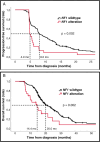Identifying targetable alterations predictive of distant progression in glioblastoma patients undergoing standard therapy
- PMID: 40575417
- PMCID: PMC12202037
- DOI: 10.1093/noajnl/vdaf092
Identifying targetable alterations predictive of distant progression in glioblastoma patients undergoing standard therapy
Abstract
Background: Infiltrative growth is a hallmark of glioblastoma (GBM) and is a major factor in therapeutic failure. Distant progression is a surrogate marker for infiltrative growth and genetic variants predictive of distant progression may serve as novel treatment targets. The aim was to identify clinical, molecular, radiographic, and genetic factors associated with distant progression in GBM patients.
Methods: From our prospective database, all consecutive GBM IDH wild type patients receiving standard therapy (Stupp regimen) from 2016 to 2021 at Rigshospitalet (Denmark) were included. Distant progression was defined as a new contrast-enhancing lesion > 2 cm from the initial lesion. Clinical, molecular, radiographic, and genomic covariates were assessed for association with time to distant progression using Cox analysis.
Results: This single-center study included 353 patients, of whom 303 patients had radiographic progression. Distant progression was found in 66 patients (22%) and was associated with poor post-progression survival (P < .001). Unmethylated MGMT (hazard ratio [HR]: 2.54, 95% confidence interval [CI]: 1.62-3.97, P < .001), and multicentric disease at diagnosis (HR: 2.32, 95% CI: 1.28-4.20, P = .005) were associated with a shorter time to distant progression. In patients with a genomic tumor profile (n = 204), the NF1 gene alteration was identified as an independent predictor of distant progression (HR: 3.48, 95% CI: 1.48-8.21, P = .004) and poor survival.
Conclusion: Distant progression is an aggressive progression pattern associated with a poor prognosis. Unmethylated MGMT, multicentric disease, and NF1 alteration independently predict distant progression. NF1 alteration may serve as a predictive biomarker for targeted treatment.
Keywords: IDHwt glioblastoma; distant progression; glioma migration; invasion; progression pattern.
© The Author(s) 2025. Published by Oxford University Press, the Society for Neuro-Oncology and the European Association of Neuro-Oncology.
Conflict of interest statement
Benedikte Hasselbalch: Advisory board member at Servier Nordics. The other authors declare no conflicts of interest.
Figures



Similar articles
-
Impact of residual disease as a prognostic factor for survival in women with advanced epithelial ovarian cancer after primary surgery.Cochrane Database Syst Rev. 2022 Sep 26;9(9):CD015048. doi: 10.1002/14651858.CD015048.pub2. Cochrane Database Syst Rev. 2022. PMID: 36161421 Free PMC article.
-
Treatment options for progression or recurrence of glioblastoma: a network meta-analysis.Cochrane Database Syst Rev. 2021 May 4;5(1):CD013579. doi: 10.1002/14651858.CD013579.pub2. Cochrane Database Syst Rev. 2021. PMID: 34559423 Free PMC article.
-
The effectiveness and cost-effectiveness of carmustine implants and temozolomide for the treatment of newly diagnosed high-grade glioma: a systematic review and economic evaluation.Health Technol Assess. 2007 Nov;11(45):iii-iv, ix-221. doi: 10.3310/hta11450. Health Technol Assess. 2007. PMID: 17999840
-
Systemic pharmacological treatments for chronic plaque psoriasis: a network meta-analysis.Cochrane Database Syst Rev. 2021 Apr 19;4(4):CD011535. doi: 10.1002/14651858.CD011535.pub4. Cochrane Database Syst Rev. 2021. Update in: Cochrane Database Syst Rev. 2022 May 23;5:CD011535. doi: 10.1002/14651858.CD011535.pub5. PMID: 33871055 Free PMC article. Updated.
-
Signs and symptoms to determine if a patient presenting in primary care or hospital outpatient settings has COVID-19.Cochrane Database Syst Rev. 2022 May 20;5(5):CD013665. doi: 10.1002/14651858.CD013665.pub3. Cochrane Database Syst Rev. 2022. PMID: 35593186 Free PMC article.
References
-
- Stupp R, Hegi ME, Mason WP, et al. ; European Organisation for Research and Treatment of Cancer Brain Tumour and Radiation Oncology Groups. Effects of radiotherapy with concomitant and adjuvant temozolomide versus radiotherapy alone on survival in glioblastoma in a randomised phase III study: 5-year analysis of the EORTC-NCIC trial. Lancet Oncol. 2009;10(5):459–466. - PubMed
LinkOut - more resources
Full Text Sources
Research Materials
Miscellaneous
